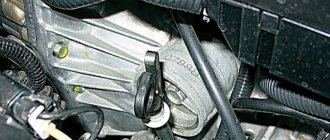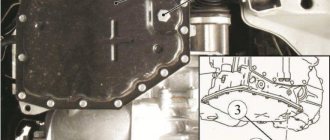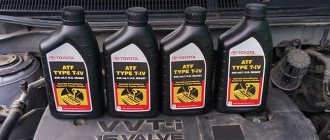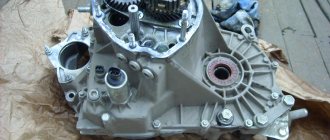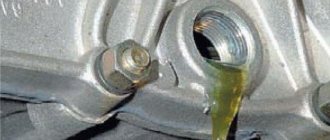All owners of cars with automatic transmission need to monitor not only the condition of the oil in the box, but also its level.
The procedure for checking the amount of transmission oil differs significantly from the same mechanics, and has its own characteristics.
Let's look at why checking the oil level in an automatic transmission, or more precisely ATF fluid, is so important and why its quantity may vary. What symptoms can you use to understand that the level is higher or lower than normal, what consequences this can lead to, and how to take measurements correctly.
Why is it necessary to check the oil level in an automatic transmission?
An automatic transmission requires regular maintenance, which includes periodically checking the level, changing the oil and filter. The quality of the transmission fluid plays a huge role in ensuring reliable operation of the unit. Oil loses its properties as it is used under the influence of numerous heating and cooling cycles. Metal particles, which are a product of frictional wear, get into it. The service interval is 60–70 thousand km, depending on the manufacturer. With intensive use this period is reduced. Failure to comply with the replacement periods specified in the vehicle’s operating instructions may result in failure of the automatic transmission.
It is equally important to maintain the required level of the special transmission fluid ATF. Most breakdowns are due to a lack of oil or too much oil. Repairs, as a rule, require significant investments of money, time, and highly qualified performers. This situation often occurs due to negligence or incorrect determination of the oil level. For this reason, every driver should be able to correctly determine the amount of transmission fluid poured into the automatic transmission.
When do you check the oil level?
Technicians recommend performing this procedure regularly. Most car owners neglect checking and operate the car from replacement to replacement. But it’s better to take the time and check the level at least once a month to avoid breakdowns. It doesn't hurt to check the level more often under the following conditions:
- high ambient temperature;
- intensive use;
- long periods of driving in heavy traffic conditions, with frequent congestion;
- aggressive driving style;
- towing heavy trailers;
- incorrect operation of the box, which can be caused by either underfilling or overfilling of oil (jerking when switching, loss of power, extraneous sounds).
Without accurately determining the level, it is impossible to correctly replace the transmission fluid.
Low ATF level
A lack of fluid in an automatic transmission can occur after prolonged use due to leaks and evaporation of ATF. If the leak occurs quickly enough, for example when the pan is punctured, the car will refuse to drive almost immediately. A small flaw is much more dangerous; it will kill the box slowly and unnoticed by the owner.
Symptoms
- Slipping and downshifting when driving, especially on an uphill climb, when the pump begins to capture air from the sump instead of oil.
- Jerks when changing gears.
- The howl of the box and the change in the sound of operation at different speeds.
Consequences
A low oil level disrupts the temperature regime of its operation - a smaller amount heats up much faster, and the liquid begins to “burn.”
The pump will capture air along with the oil, resulting in an air-oil emulsion, which is a compressible liquid. The torque converter in an automatic transmission works precisely due to fluid pressure, and a change in its characteristics will affect the correct operation of this unit, and the entire box as a whole.
The ATF life will decrease and it will have to be changed much faster.
The lubrication of the gearbox parts and heat dissipation will deteriorate, resulting in a reduction in the service life of the automatic transmission itself.
How to check the oil level in an automatic transmission
Modern automatic transmissions are produced in two types: with and without a control probe. In the first case, as a rule, the manufacturer indicates the need for regular oil changes and provides for the possibility of checking its level by the driver himself. The absence of a dipstick indicates that manufacturers believe that there is no need to change the oil during the entire service life, or they prefer to entrust the level check to car service specialists.
Topping up rules
There are situations when servicing manual transmissions when a check shows the normal condition of the lubricant, but its quantity does not meet the standards established by the automaker. Therefore, topping up is required.
Only the same oil that is currently in the box is poured. If you cannot purchase this lubricant, you cannot add or mix different types of lubricants, even with identical characteristics. This will require a complete replacement.
In the case when there is oil for topping up, you need to focus on the design features of the manual transmission:
- Filler plug. Most cars with manual transmissions have a special filler neck closed with a protective plug. Most often it is installed under the car in the upper part of the crankcase. You need to get under the car, unscrew the cap and fill in the missing amount.
- No filler plug. It also happens that the filler plug is missing. But there is a dipstick. It can be used not only to check the level, but also for filling. To do this, take a medical syringe, fill it with oil from a jar, and then pour it into the hole for the dipstick.
- Without filler plug and dipstick. Sometimes it happens. Some cars with manual transmission do not have a filler hole and dipstick. To get out of this situation, you can use the sensor holes. Some controllers are installed in a box. After unscrewing them, you can add lubricant. Most often, reverse sensors and speed sensors are suitable for such purposes.
Proceed with extreme caution so as not to turn the problem of oil deficiency into a problem of its excess.
Since most cars with manual transmissions have filler holes and a dipstick, adding lubricant should not be a problem.
Checking the level in the automatic transmission with a dipstick
First of all, you need to find the dipstick. There are two of them in the car, one for checking the oil level in the automatic transmission, the second in the engine. The exact location is indicated in the vehicle's operating instructions. If it is lost, you can inspect the engine compartment yourself. For this:
- open the hood;
- stand facing the direction of the car;
- Find the brightly colored handle on the right side, located closer to the partition of the engine compartment. This is the notorious dipstick.
In some models, both probes are located next to each other. You can distinguish them by color. The one that is designed to control engine oil is usually yellow in color. The same part for automatic transmission has a different, contrasting color.
Once the dipstick is found, it must be removed and inspected. There will be two marks on it with the inscriptions “COLD” and “HOT”, which corresponds to the level of hot and cold liquid. Vehicles with a manual gearbox do not have such marks. Accordingly, the level can be checked in both cold and hot automatic transmissions. The first method is considered less accurate, rather informing about the presence of oil.
High ATF level
The main reason for a high oil level is precisely incorrect measurements, after which the car owner begins to independently add fluid to the box.
When replacing at a service station, workers may also fill too much. The reason is simple: hot fluid is drained, cold fluid is poured in, and hot ATF has a much larger volume. This means that the cold one will subsequently expand even more.
Symptoms
You can determine that the oil level is above normal by the following signs.
- The transmission begins to become dull, kick, and gears may not engage.
- ATF leaks in the area of the breather, dipstick, seals. It is no coincidence that it is red in color, which distinguishes it from all other process fluids.
- Foam on the dipstick. It’s not just the presence of bubbles, but a stable foamed liquid.
Consequences
The clutch discs begin to slip relative to each other, and this leads to their combustion and increased wear.
The consequences of overfilling are almost the same as with underfilling. The liquid begins to reach the rotating parts of the box and foam, forming an emulsion. Only in addition to compressibility and poor heat transfer, you also get a serious increase in the volume of ATF, the excess of which will be released through the breather of the automatic transmission ventilation system.
Checking the level on a cold automatic transmission
The sequence of actions is as follows:
- Place the car on a flat horizontal platform.
- Start the engine and let it idle, alternately moving the automatic selector to all existing positions. This will ensure sufficient fluidity of the ATF fluid.
- Switch the selector to P (parking) mode.
- Remove the dipstick. The engine continues to run.
- Wipe it with a clean rag.
- Insert back into the slot.
- Remove the dipstick again.
- Check fluid level.
The reference point will be the COLD mark. If the level is below this mark, the oil must be added to the required level, and then the procedure must be repeated. A level above the mark indicates an excess quantity. It is recommended to drain the excess.
Required volume
Motorists often ask questions about the optimal oil level in manual transmissions. It is important for them to know exactly how much lubricant should be inside the manual transmission for correct and trouble-free operation.
But it is impossible to answer unequivocally what exactly the oil level should be in a mechanical type gearbox. This characteristic is individual for each individual car.
Depending on the brand and model, the boxes may differ in their design and internal volume, which is filled with gear lubricant.
To accurately answer your question, you need to use strictly official documentation. The easiest way to find data on gearbox capacity is in the owner's manual. In the technical documents, the manufacturer prescribes all the necessary characteristics, including the amount of lubricant required for a specific manual transmission installed on the car.
In addition to the quantity, the characteristics of the oil are also indicated. Here we are talking about the degree of viscosity, seasonality and other nuances. Violating them is strongly discouraged.
At the same time, motorists do not fully understand why it is so important to fill in a strictly regulated amount of lubricant. After all, you can fill in a little more, and then you won’t have to top up soon. The nodes will be lubricated more intensively due to an increase in the volume of lubricant. But this opinion is wrong. Oil is poured into the manual transmission strictly in accordance with established standards.
Mechanical lubrication performs several functions:
- lubricates surfaces, preventing their active friction;
- removes heat;
- improves the performance of elements that come into contact with each other;
- removes dirt;
- extends the service life of the entire assembly.
If there is too little oil, it will not be able to fully perform its tasks. Excess is also dangerous, since leaks occur, oil penetrates into systems where it should not be, gaskets and seals fail. And this is a direct road to expensive repairs.
When creating a manual transmission design, the automaker clearly determines at what level the box can work as efficiently as possible, coping with its functions, and without wearing out ahead of time. The appropriate levels are set on the measuring probe, which further help the car owner maintain the parameters set at the factory.
Automatic transmission without dipstick
Such units have filler and drain holes, as well as a tube connecting to the pan. There cannot be a lot of oil in such a box; the excess goes into the pan through this tube. The level is checked as follows:
- warm up the oil by traveling a sufficient distance (15–20 km);
- install the car on a flat overpass or inspection hole;
- set the selector to parking mode with the engine running after first switching to different modes;
- unscrew the drain plug, replacing the container, the engine continues to run.
When the liquid does not flow out at all, the level is insufficient. If there is enough emulsion, it will flow briefly in a small, even stream.
Regardless of the method chosen, it is recommended to check the level again after a few days. This will give a more accurate picture. You should pay attention to the condition of the transmission fluid. Cloudiness, as well as the presence of slag and metal impurities, indicates the need to replace the ATF fluid. By learning to check the oil level in an automatic transmission yourself, you can save significant money. There is no need to frequently visit car repair shops.
Let's sum it up
Repairing a manual transmission is quite expensive, and malfunctions in the gearbox, if the problem is not detected in a timely manner, can affect other operating components of the machine. It’s actually not difficult to protect yourself from such a precedent: you just need to monitor the lubricant level in accordance with the manufacturer’s regulations, respond to inconsistencies in the operation of transmission units by instantly searching for a malfunction and eliminating it.
Check the oil regularly, avoid heavy loads on the manual transmission, preferring a calm driving mode, fill the transmission units only with fluids of decent quality - and the gearbox will serve you reliably throughout the entire operating period of the car.
Helpful information
If, when checking the oil in the box, you find a “shortage”, in addition to restoring the volume, you need to find the reason. Most often, it is enough to carry out an external inspection of the gearbox. Leakage is localized by replacing seals, gaskets, and restoring the integrity of the housing.
Advice.
To assess the condition of the lubricant by color, you need to compare the sample on the level indicator with a drop of fresh transmission oil. The liquid should not contain soot, solid particles, or water emulsion.
Features of checking cars of different brands
| Brand | Peculiarity |
| Audi | The manufacturer does not equip its automatic transmissions with dipsticks. Instead, viewing windows are used. Most often they are located on the bottom. Therefore, you need to check the oil level by driving the car onto an overpass or pit. If the model is equipped with a dipstick, then the oil level in the gearbox is checked when the gear is engaged in neutral, and not in park. |
| Volkswagen | |
| BMW | Like Audi, the German concern often equips its automatic transmission with a viewing window. If there is a probe, then the check is performed according to the described algorithm. |
| Dodge | The check is carried out in neutral gear |
| Hyundai | |
| Jeep | |
| Mazda | |
| Mitsubishi | |
| Honda | On some models, the amount of lubricant must be determined when the engine is cold. |
Not only a lack of lubricant can cause problems with the gearbox.
Its functioning is also affected by production and oxidation. The quality of the composition can be determined by color and smell. Drip a little liquid from the dipstick onto a clean rag. What else to pay attention to What to pay attention to:
- The composition must be transparent and not have any inclusions. If there are metal particles, the filter is dirty, for some reason there is increased wear of parts, or the magnet at the bottom of the oil compartment is not working.
- A black coating on the dipstick may indicate that the device has not been used for a long time. Therefore, you need to wipe it and repeat the test. If the plaque appears again, there is a problem.
- An unpleasant, rotten smell indicates spoiled liquid. But you should trust this indicator only if you know exactly what fresh machine lubricant smells like.
Each of these signs is a reason to visit a car repair shop. If there is a malfunction in the box, it is better to identify and eliminate it in the early stages. A major overhaul of an aggregate unit will take much longer and require more money.
Correct oil level Toyota, Renault, Opel, Audi, Ford: values
Below you will find the correct oil level for such car brands as Toyota, Renault, Opel, Audi, Ford. The oil level is indicated in liters:
- Toyota (Toyota) with automatic transmission - 3.5-4.2 l ; Toyota with manual transmission - 2.2-2.8 l .
- Renault (Renault) with manual transmission - 3.1-3.8 l ; Renault with automatic transmission - 2.5-3 liters.
- Opel (Opel) with automatic transmission - 3.8-4.3 l ; Opel with manual transmission - 1.8-2.2 l .
- Audi (Audi) with automatic transmission - 5-8 l ; Audi with manual transmission - 2.7-3.5 l .
- Ford (Ford) with automatic transmission - 5.8-6.7 l ; Ford with manual transmission - 2.9-3.4 liters .
In these car models, the oil level should be exactly like this. If you have a different brand of car, look for the required indicators below.
Consequences of low fluid level in the automatic transmission
If the oil level is below the Hot mark, this means that there is little fluid or there are leaks in the unit.
Inspecting the underbody of the car, you can find damaged hoses, deformed elements, loose connections, dirty and frayed seals. If there is not enough transmission oil or it is leaking, the oil pump will suck in air.
The structure of the emulsion changes, resulting in unpleasant consequences:
- the power of the torque converter decreases and it has to take on additional load;
- the pressure on the clutches decreases, so when changing gears there are sharp jerks, and the discs wear out faster due to slipping;
- impurities appear in the oil, which clog the valve body channels, pump filters, hoses and solenoids;
- the liquid loses its beneficial properties and the system begins to overheat.
By adding oil to the required level, you can prevent wear of the automatic transmission ahead of schedule. It is forbidden to mix liquids of different types, as this may provoke an undesirable chemical reaction.
You should fill the system with the oil that was originally inside, or the one recommended by the car manufacturer.
Correct oil level values for Nissan, Subaru, Hyundai, Rav 4, Corolla, Lexus, Cruze
If you did not find your car brand above to see the correct oil level, then look at the list below. Nissan, Subaru, Hyundai, Rav 4, Corolla, Lexus, Cruz - the oil level values should be as follows:
- Nissan (Nissan) with automatic transmission - 2.8-4.2 l ; Nissan with manual transmission - 1.5-2.2 l .
- Subaru (Subaru) with automatic transmission - 2.6-4.2 l ; Subaru with manual transmission - 1.8-2.2 l .
- Hyundai with automatic transmission - 4.5-5 l ; Hyundai with manual transmission - 1.9-2.3 l .
- Lexus (Lexus) with automatic transmission - 3.8-5 l ; Lexus with manual transmission - 1.7-2.8 l .
- Rav 4 with automatic transmission - 3.8-4.9 l ; Rav 4 with manual transmission - 1.8-2.1 l .
- Corolla with automatic transmission - 4.5-5 l ; Corolla with manual transmission - 1.9-2.2 l .
- Cruze with automatic transmission - 4.3-4.9 l ; Cruze with manual transmission - 1.9-2.2 liters .
All values are listed. Now you can check the oil level in your car.
